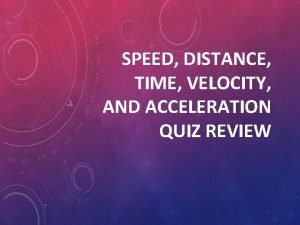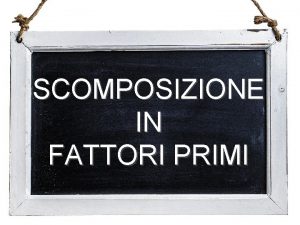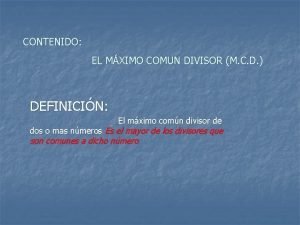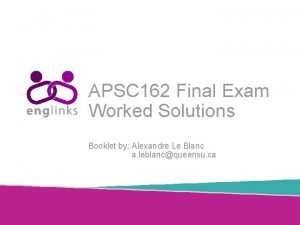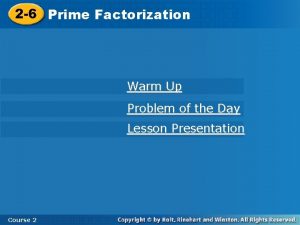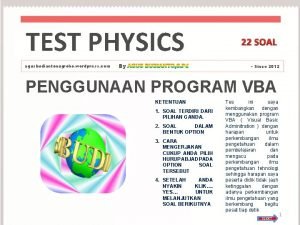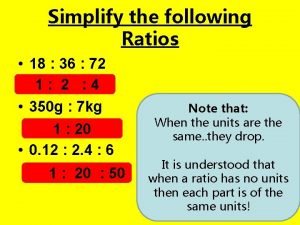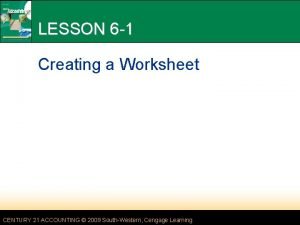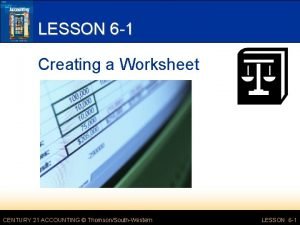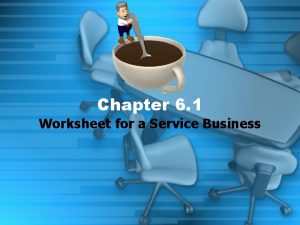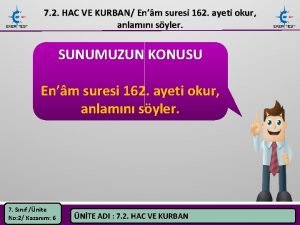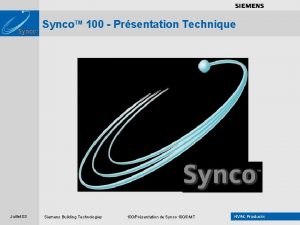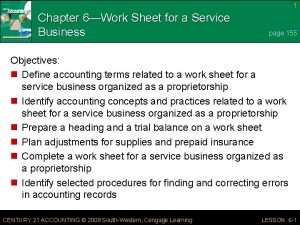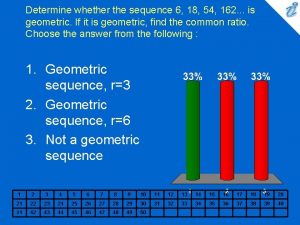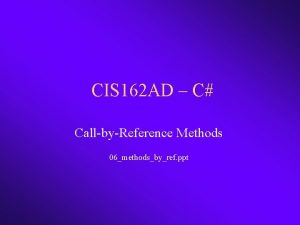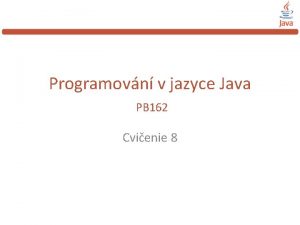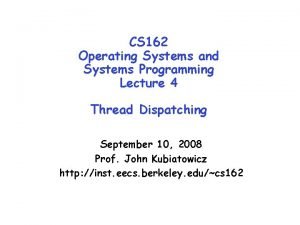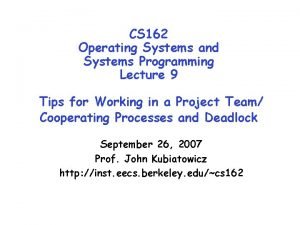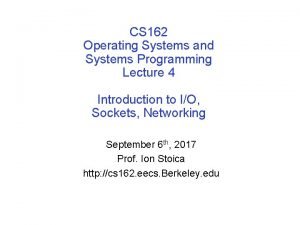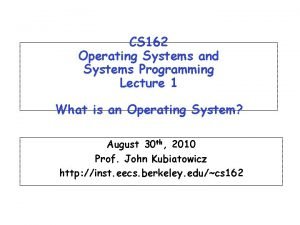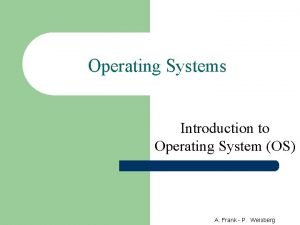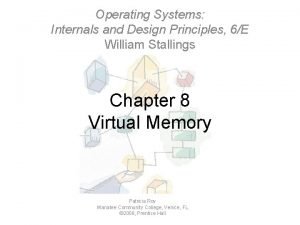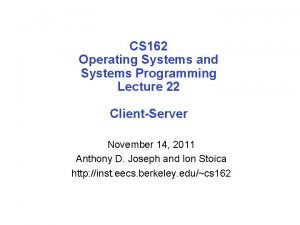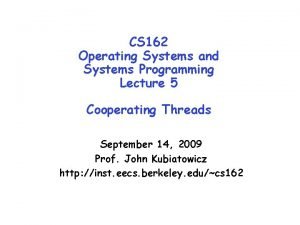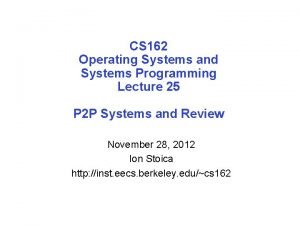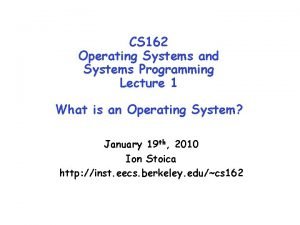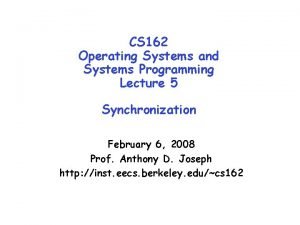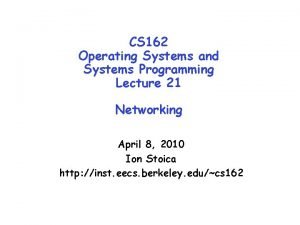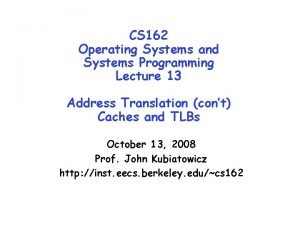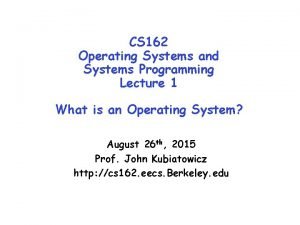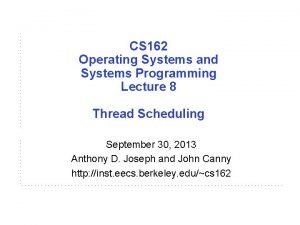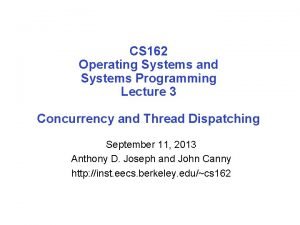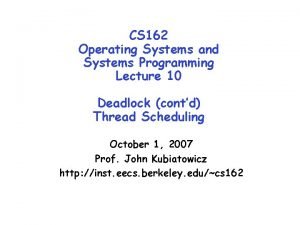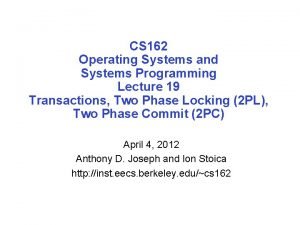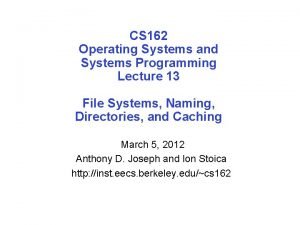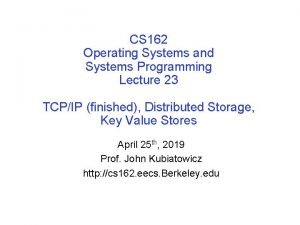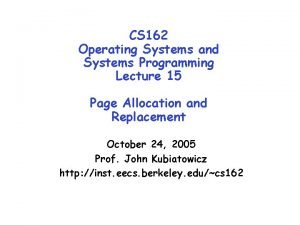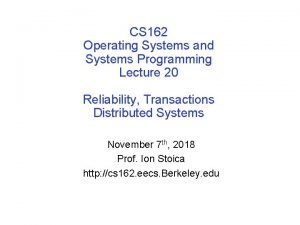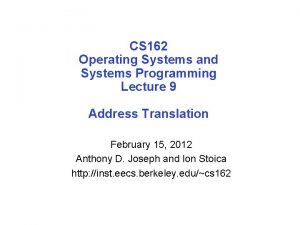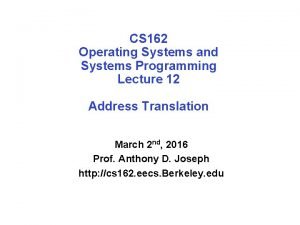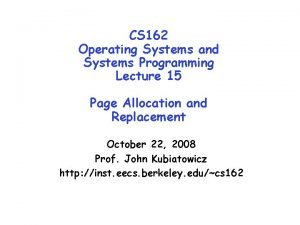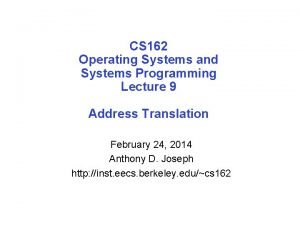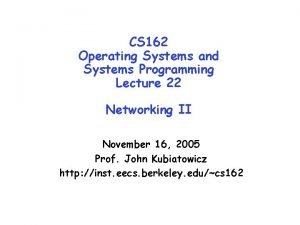CS 162 Operating Systems and Systems Programming Lecture




























![Optimize I/O Performance Queue [OS Paths] Controller User Thread 300 Response Time (ms) I/O Optimize I/O Performance Queue [OS Paths] Controller User Thread 300 Response Time (ms) I/O](https://slidetodoc.com/presentation_image/3edc22a8fd528589d826aeb680638f33/image-29.jpg)






- Slides: 35

CS 162 Operating Systems and Systems Programming Lecture 17 Performance Storage Devices, Queueing Theory October 26 th, 2016 Prof. Anthony D. Joseph http: //cs 162. eecs. Berkeley. edu

Review: Basic Performance Concepts • Response Time or Latency: Time to perform an operation(s) • Bandwidth or Throughput: Rate at which operations are performed (op/s) – Files: m. B/s, Networks: mb/s, Arithmetic: GFLOP/s • Start up or “Overhead”: time to initiate an operation • Most I/O operations are roughly linear in n bytes – Latency(n) = Overhead + n/Bandwidth 10/26/16 Joseph CS 162 ©UCB Fall 2016 Lec 17. 2

Review: Storage Devices • Magnetic disks – Storage that rarely becomes corrupted – Large capacity at low cost – Block level random access (except for SMR – later!) – Slow performance for random access – Better performance for streaming access • Flash memory – Storage that rarely becomes corrupted – Capacity at intermediate cost (8 x disk ? ? ? ) – Block level random access – Good performance for reads; worse for random writes – Erasure requirement in large blocks – Wear patterns issue 10/26/16 Joseph CS 162 ©UCB Fall 2016 Lec 17. 3

Review: Magnetic Disk Characteristic • Cylinder: all the tracks under the Head head at a given point on all surfaces • Read/write: three-stage process: Sector Track Cylinder Platter – Seek time: position head/arm over proper track (into proper cylinder) – Rotational latency: wait for desired sector to rotate under R/W head – Transfer time: transfer a block of bits (sector) under the R/W head Joseph CS 162 ©UCB Fall 2016 Result 10/26/16 Hardware Controller Request • Disk Latency = Queuing Time + Controller time + Software Media Time Seek Time + Rotation Time + Xfer Queue (Seek+Rot+Xfer) Time (Device Driver) Lec 17. 4

Disk Performance Example • Assumptions: – Ignoring queuing and controller times for now – Avg seek time of 5 ms, – 7200 RPM Time for rotation: 60000(ms/minute)/7200(rev/min) ~= 8 ms – Transfer rate of 4 MByte/s, sector size of 1 Kbyte 1024 bytes/4× 106 (bytes/s) = 256 × 10 -6 sec . 26 ms • Read sector from random place on disk: – Seek (5 ms) + Rot. Delay (4 ms) + Transfer (0. 26 ms) – Approx 10 ms to fetch/put data: 100 KByte/sec • Read sector from random place in same cylinder: – Rot. Delay (4 ms) + Transfer (0. 26 ms) – Approx 5 ms to fetch/put data: 200 KByte/sec • Read next sector on same track: – Transfer (0. 26 ms): 4 MByte/sec • Key to using disk effectively (especially for file 10/26/16 Joseph CS 162 ©UCB Fall 2016 Lec 17. 5 systems) is to minimize seek and rotational delays

(Lots of) Intelligence in the Controller • Sectors contain sophisticated error correcting codes – Disk head magnet has a field wider than track – Hide corruptions due to neighboring track writes • Sector sparing – Remap bad sectors transparently to spare sectors on the same surface • Slip sparing – Remap all sectors (when there is a bad sector) to preserve sequential behavior • Track skewing – Sector numbers offset from one track to the next, to allow for disk head movement for sequential ops • … 10/26/16 Joseph CS 162 ©UCB Fall 2016 Lec 17. 6

Goals for Today • Solid State Disks • Discussion of performance – Queuing Theory – Hard Disk Drive Scheduling • Start on filesystems 10/26/16 Joseph CS 162 ©UCB Fall 2016 Lec 17. 7

Solid State Disks (SSDs) • 1995 – Replace rotating magnetic media with non-volatile memory (battery backed DRAM) • 2009 – Use NAND Multi-Level Cell (2 or 3 -bit/cell) flash memory – Sector (4 KB page) addressable, but stores 4 -64 “pages” per memory block – Trapped electrons distinguish between 1 and 0 • No moving parts (no rotate/seek motors) – Eliminates seek and rotational delay (0. 1 -0. 2 ms access time) – Very low power and lightweight 10/26/16– Limited “write cycles” Joseph CS 162 ©UCB Fall 2016 Lec 17. 8

SSD Architecture – Reads Host SATA Buffer Manager (software Queue) Flash Memory Controller DRAM Read 4 KB Page: ~25 usec – No seek or rotational latency – Transfer time: transfer a 4 KB page NAND NAND NAND NAND NAND NAND NAND NAND » SATA: 300 -600 MB/s => ~4 x 103 b / 400 x 106 bps => 10 us – Latency = Queuing Time + Controller time + Xfer Time 10/26/16 Joseph CS 162 ©UCB Fall 2016 Lec 17. 9 – Highest Bandwidth: Sequential OR Random reads

SSD Architecture – Writes • Writing data is complex! (~200μs – 1. 7 ms ) – Can only write empty pages in a block – Erasing a block takes ~1. 5 ms – Controller maintains pool of empty blocks by coalescing used pages (read, erase, write), also reserves some % of capacity • Rule of thumb: writes 10 x reads, erasure 10 x writes https: //en. wikipedia. org/wiki/Solid-state_drive 10/26/16 Joseph CS 162 ©UCB Fall 2016 Lec 17. 10

Amusing calculation: is a full Kindle heavier than an empty one? • Actually, “Yes”, but not by much • Flash works by trapping electrons: – So, erased state lower energy than written state • Assuming that: – Kindle has 4 GB flash – ½ of all bits in full Kindle are in high-energy state – High-energy state about 10 -15 joules higher – Then: Full Kindle is 1 attogram (10 -18 gram) heavier (Using E = mc 2) • Of course, this is less than most sensitive scale can measure (it can measure 10 -9 grams) • Of course, this weight difference overwhelmed by battery discharge, weight from getting warm, …. • According to John Kubiatowicz (New York Times, Oct 24, 10/26/16 Joseph CS 162 ©UCB Fall 2016 Lec 17. 11

Storage Performance & Price (2016) Bandwidth (Sequential R/W) Cost/GB Size HDD 2 50 -100 MB/s $0. 03/GB 2 -10 TB SSD 1, 2 200 -550 MB/s (SATA) 6 GB/s (read PCI) 4. 4 GB/s (write PCI) $0. 22/GB 200 GB-1 TB DRAM 2 10 -16 GB/s $4/GB 8 -256 GB 1 http: //www. fastestssd. com/featured/ssd-rankings-the-fastest-solid-state-drives/ 2 http: //www. extremetech. com/computing/164677 -storage-pricewatch-hard-drive-and-ssd-prices-drop-making-for-a-good-time-to-buy BW: SSD up to x 10 than HDD, DRAM > x 10 than SSD Price: HDD x 8 less than SSD, SSD x 20 less than DRAM 10/26/16 Joseph CS 162 ©UCB Fall 2016 Lec 17. 12

SSD Summary • Pros (vs. hard disk drives): – Low latency, high throughput (eliminate seek/rotational delay) – No moving parts: » Very light weight, low power, silent, very shock insensitive – Read at memory speeds (limited by controller and I/O bus) • Cons – Small storage (0. 1 -0. 5 x disk), expensive (8 x disk ? ? ? ) » Hybrid alternative: combine small SSD with large HDD – Asymmetric block write performance: read pg/erase/write pg » Controller garbage collection (GC) algorithms have major effect on performance – Limited drive lifetime » 1 -10 K writes/page for MLC NAND » Avg failure rate is 6 years, life expectancy is 9– 11 years • These are changing rapidly! 10/26/16 Joseph CS 162 ©UCB Fall 2016 Lec 17. 13

Review: Life Cycle of An I/O Request User Program Kernel I/O Subsystem Device Driver Top Half Device Driver Bottom Half Device Hardware 10/26/16 Joseph CS 162 ©UCB Fall 2016 Lec 17. 14

What Goes into Startup Cost for I/O? • Syscall overhead • Operating system processing • Controller Overhead • Device Startup – Mechanical latency for a disk – Media Access + Speed of light + Routing for network • Queuing (next topic) 10/26/16 Joseph CS 162 ©UCB Fall 2016 Lec 17. 15

I/O Performance Controller User Thread 300 Response Time (ms) I/O device 200 Queue 100 [OS Paths] Response Time = Queue + I/O device service time • Performance of I/O subsystem 0 0% 100% – Metrics: Response Time, Throughput (Utilization) (% total BW) – Effective BW per op = transfer size / response time » Eff. BW(n) = n / (S + n/B) = B / (1 + SB/n ) – Contributing factors to latency: » Software paths (can be loosely modeled by a queue) » Hardware controller » I/O device service time • Queuing behavior: – Can lead to big increases of latency as utilization increases – Solutions? 10/26/16 Joseph CS 162 ©UCB Fall 2016 Lec 17. 16

Administrivia • Midterm #2 grades published – Regrade request deadline Mon 10/31 at 5 pm – Please only submit regrade requests for grading errors! • Project 2 – Code due Monday 10/31 – Final report due Wednesday 11/2 10/26/16 Joseph CS 162 ©UCB Fall 2016 Lec 17. 17

BREAK 10/26/16 Joseph CS 162 ©UCB Fall 2016 Lec 17. 18

A Simple Deterministic World Queue arrivals TQ TA Server departures TS TA TA • Assume requests arrive at regular intervals, take a fixed time to process, with plenty of time between … • Service rate (μ = 1/TS) - operations per sec • Arrival rate: (λ = 1/TA) - requests per second • Utilization: U = λ/μ , where λ < μ • Average rate is the complete story 10/26/16 Joseph CS 162 ©UCB Fall 2016 Lec 17. 19

time Saturation 1 Empty Queue Unbounded 0 1 Offered Load (TS/TA) Queue delay 0 1 Offered Load (TS/TA) Delivered Throughput 1 Queue delay Delivered Throughput A Ideal Linear World time • What does the queue wait time look like? – Grows unbounded at a rate ~ (Ts/TA) till request rate subsides 10/26/16 Joseph CS 162 ©UCB Fall 2016 Lec 17. 20

A Bursty World arrivals Queue TQ Server departures TS Arrivals Q depth Server • Requests arrive in a burst, must queue up till served • Same average arrival time, but almost all of the requests experience large queue delays • Even though average utilization is low 10/26/16 Joseph CS 162 ©UCB Fall 2016 Lec 17. 21

So how do we model the burstiness of arrival? • Elegant mathematical framework if you start with exponential distribution – Probability density function of a continuous random variable with a mean of 1/λ – f(x) = λe-λx – “Memoryless” 1 Likelihood of an event occurring is independent of how long we’ve been waiting Lots of short arrival intervals (i. e. , high instantaneous rate) Few long gaps (i. e. , low instantaneous rate) 10/26/16 0. 9 0. 8 0. 7 mean arrival interval (1/λ) 0. 6 0. 5 0. 4 0. 3 0. 2 0. 1 0 0 Joseph CS 162 ©UCB Fall 2016 2 4 6 x (λ) 8 10 Lec 17. 22

Background: General Use of Random Distributions • Server spends variable time with customers – Mean (Average) m 1 = p(T) T – Variance (stddev 2) 2 = p(T) (T-m 1)2 = p(T) T 2 -m 12 – Squared coefficient of variance: C = 2/m 12 Aggregate description of the distribution Mean (m 1) Distribution of service times • Important values of C: – No variance or deterministic C=0 – “Memoryless” or exponential C=1 mean » Past tells nothing about future » Poisson process – purely or completely random process » Many complex systems (or aggregates) Memoryless are well described as memoryless – Disk response times C 1. 5 (majority seeks < average) 10/26/16 Joseph CS 162 ©UCB Fall 2016 Lec 17. 23

Introduction to Queuing Theory Queue Controller Arrivals Disk Departures Queuing System • What about queuing time? ? – Let’s apply some queuing theory – Queuing Theory applies to long term, steady state behavior Arrival rate = Departure rate • Arrivals characterized by some probabilistic distribution • Departures characterized by some probabilistic Joseph CS 162 ©UCB Fall 2016 Lec 17. 24 10/26/16

Little’s Law arrivals N departures B L • In any stable system – Average arrival rate = Average departure rate • The average number of tasks in the system (N) is equal to the throughput (B) times the response time (L) – N (ops) = B (ops/s) x L (s) • Regardless of structure, bursts of requests, variation in service – Instantaneous variations, but it washes out in the 10/26/16 average Joseph CS 162 ©UCB Fall 2016 Lec 17. 25

• A Little Queuing Theory: Some Results Assumptions: – System in equilibrium; No limit to the queue – Time between successive arrivals is random and memoryless Queue Server Arrival Rate Service Rate μ=1/Tser • Parameters that describe our system: – : mean number of arriving customers/second – Tser: mean time to service a customer (“m 1”) – C: squared coefficient of variance = 2/m 12 – μ: service rate = 1/Tser – u: server utilization (0 u 1): u = /μ = Tser • Parameters we wish to compute: – Tq: Time spent in queue – Lq: Length of queue = Tq (by Little’s law) • Results (M: Poisson arrival process, 1 server): – Memoryless service time distribution (C = 1): Called an M/M/1 queue » Tq = Tser x u/(1 – u) – General service time distribution (no restrictions): Called an M/G/1 queue » Tq = Tser x ½(1+C) x u/(1 – u)) 10/26/16 Joseph CS 162 ©UCB Fall 2016 Lec 17. 26

A Little Queuing Theory: An Example • Example Usage Statistics: – User requests 10 x 8 KB disk I/Os per second – Requests & service exponentially distributed (C=1. 0) – Avg. service = 20 ms (From controller + seek + rotation + transfer) • Questions: – How utilized is the disk (server utilization)? Ans: , u = Tser – What is the average time spent in the queue? Ans: Tq – What is the number of requests in the queue? Ans: Lq – What is the avg response time for disk request? Ans: Tsys = Tq + Tser • Computation: (avg # arriving customers/s) = 10/s Tser (avg time to service customer) = 20 ms (0. 02 s) u (server utilization) = x Tser= 10/s x. 02 s = 0. 2 Tq (avg time/customer in queue) = Tser x u/(1 – u) = 20 x 0. 2/(1 -0. 2) = 20 x 0. 25 = 5 ms (0. 005 s) 10/26/16 Joseph CS 162 ©UCB Fall 2016 Lec 17. 27

Queuing Theory Resources • Resources page contains Queueing Theory Resources (under Readings): – Scanned pages from Patterson and Hennessy book that gives further discussion and simple proof for general equation: https: //cs 162. eecs. berkeley. edu/static/readings/patterson _queue. pdf – A complete website full of resources: http: //web 2. uwindsor. ca/math/hlynka/qonline. html • Some previous midterms with queueing theory questions • Assume that Queueing Theory is fair game for Midterm III 10/26/16 Joseph CS 162 ©UCB Fall 2016 Lec 17. 28
![Optimize IO Performance Queue OS Paths Controller User Thread 300 Response Time ms IO Optimize I/O Performance Queue [OS Paths] Controller User Thread 300 Response Time (ms) I/O](https://slidetodoc.com/presentation_image/3edc22a8fd528589d826aeb680638f33/image-29.jpg)
Optimize I/O Performance Queue [OS Paths] Controller User Thread 300 Response Time (ms) I/O device 200 100 Response Time = Queue + I/O device service time • How to improve performance? 0 – Make everything faster – More Decoupled (Parallelism) systems – Do other useful work while waiting 0% 100% Throughput (Utilization) (% total BW) » Multiple independent buses or controllers – Optimize the bottleneck to increase service rate » Use the queue to optimize the service • Queues absorb bursts and smooth the flow • Add admission control (finite queues) – Limits delays, but may introduce unfairness and livelock 10/26/16 Joseph CS 162 ©UCB Fall 2016 Lec 17. 29

When is Disk Performance Highest? • When there are big sequential reads, or • When there is so much work to do that they can be piggy backed (reordering queues—one moment) • OK to be inefficient when things are mostly idle • Bursts are both a threat and an opportunity • <your idea for optimization goes here> – Waste space for speed? • Other techniques: – Reduce overhead through user level drivers – Reduce the impact of I/O delays by doing other useful work in the meantime 10/26/16 Joseph CS 162 ©UCB Fall 2016 Lec 17. 30

Disk Scheduling 2, 3 2, 1 3, 10 7, 2 5, 2 2, 2 • Disk can do only one request at a time; What order do you choose to do queued requests? User Head Requests • FIFO Order • SSTF: Shortest seek time first – Pick the request that’s closest on the disk – Although called SSTF, today must include rotational delay in calculation, since rotation can be as long as seek – Con: SSTF good at reducing seeks, but may lead to starvation 3 2 1 4 Disk Head – Fair among requesters, but order of arrival may be to random spots on the disk Very long seeks • SCAN: Implements an Elevator Algorithm: take the closest request in the direction of travel – No starvation, but retains flavor of SSTF • C-SCAN: Circular-Scan: only goes in one direction – Skips any requests on the way back – Fairer than SCAN, not biased towards pages in middle 10/26/16 Joseph CS 162 ©UCB Fall 2016 Lec 17. 31

Building a File System • File System: Layer of OS that transforms block interface of disks (or other block devices) into Files, Directories, etc. • File System Components – Disk Management: collecting disk blocks into files – Naming: Interface to find files by name, not by blocks – Protection: Layers to keep data secure – Reliability/Durability: Keeping of files durable despite crashes, media failures, attacks, etc. • User vs. System View of a File – User’s view: » Durable Data Structures – System’s view (system call interface): » Collection of Bytes (UNIX) » Doesn’t matter to system what kind of data structures you want to store on disk! – System’s view (inside OS): » Collection of blocks (a block is a logical transfer unit, while a sector is the physical transfer unit) » Block size sector size; in UNIX, block size is 4 KB 10/26/16 Joseph CS 162 ©UCB Fall 2016 Lec 17. 32

Translating from User to System View File System • What happens if user says: give me bytes 2— 12? – Fetch block corresponding to those bytes – Return just the correct portion of the block • What about: write bytes 2— 12? – Fetch block – Modify portion – Write out Block • Everything inside File System is in whole size blocks – For example, getc(), putc() buffers something like 4096 bytes, even if interface is one byte at a time • From now on, file is a collection of blocks 10/26/16 Joseph CS 162 ©UCB Fall 2016 Lec 17. 33

Disk Management Policies • Basic entities on a disk: – File: user-visible group of blocks arranged sequentially in logical space – Directory: user-visible index mapping names to files (next lecture) • Access disk as linear array of sectors. Two Options: – Identify sectors as vectors [cylinder, surface, sector], sort in cylinder-major order, not used anymore – Logical Block Addressing (LBA): Every sector has integer address from zero up to max number of sectors – Controller translates from address physical position » First case: OS/BIOS must deal with bad sectors » Second case: hardware shields OS from structure of disk • Need way to track free disk blocks – Link free blocks together too slow today – Use bitmap to represent free space on disk • Need way to structure files: File Header – Track which blocks belong at which offsets within the logical file structure – Optimize placement of files’ disk blocks to match access and 10/26/16 Joseph CS 162 ©UCB Fall 2016 Lec 17. 34

Summary • Disk Performance: – Queuing time + Controller + Seek + Rotational + Transfer – Rotational latency: on average ½ rotation – Transfer time: spec of disk depends on rotation speed and bit storage density • Devices have complex interaction and performance characteristics – Response time (Latency) = Queue + Overhead + Transfer » Effective BW = BW * T/(S+T) – HDD: Queuing time + controller + seek + rotation + transfer – SDD: Queuing time + controller + transfer (erasure & wear) • Systems (e. g. , file system) designed to optimize performance and reliability – Relative to performance characteristics of underlying device • Bursts & High Utilization introduce queuing delays • Queuing Latency: – M/M/1 and M/G/1 queues: simplest to analyze – As utilization approaches 100%, latency Tq = Tser x ½(1+C) x u/(1 – u)) 10/26/16 Joseph CS 162 ©UCB Fall 2016 Lec 17. 35
 Operating system lecture notes
Operating system lecture notes 01:640:244 lecture notes - lecture 15: plat, idah, farad
01:640:244 lecture notes - lecture 15: plat, idah, farad C data types with examples
C data types with examples Prime factorization of 80 using exponents
Prime factorization of 80 using exponents Velocity=distance/time
Velocity=distance/time Come si scompongono i numeri decimali
Come si scompongono i numeri decimali Prime factor of 270
Prime factor of 270 Mcd de 126 y 12
Mcd de 126 y 12 Apsc 162
Apsc 162 What is the prime factorization of 24
What is the prime factorization of 24 Ggl induksi sebesar 162 v timbul pada kumparan
Ggl induksi sebesar 162 v timbul pada kumparan What is 18/36 simplified
What is 18/36 simplified 6-1 work together p. 162 answers
6-1 work together p. 162 answers 6-1 work together p. 162 answers
6-1 work together p. 162 answers 6-1 work together p. 162 answers
6-1 work together p. 162 answers 7 sınıf en'âm suresi 162. ayet
7 sınıf en'âm suresi 162. ayet Rle 162
Rle 162 6-4 work together p. 170
6-4 work together p. 170 Hlinex, 0,1,2,3 hlinef (x),6,18,54,162 hline
Hlinex, 0,1,2,3 hlinef (x),6,18,54,162 hline 162 ad
162 ad Pb162
Pb162 Cs 162
Cs 162 Cs 162
Cs 162 Cs 162
Cs 162 Cs 162
Cs 162 Fourth root of 162
Fourth root of 162 Perbedaan linear programming dan integer programming
Perbedaan linear programming dan integer programming Greedy vs dynamic
Greedy vs dynamic Definition of system programming
Definition of system programming Linear vs integer programming
Linear vs integer programming Definisi integer
Definisi integer Can we make operating systems reliable and secure
Can we make operating systems reliable and secure Operating systems: internals and design principles
Operating systems: internals and design principles Module 4 operating systems and file management
Module 4 operating systems and file management Slidetodoc.com
Slidetodoc.com Operating systems: internals and design principles
Operating systems: internals and design principles




